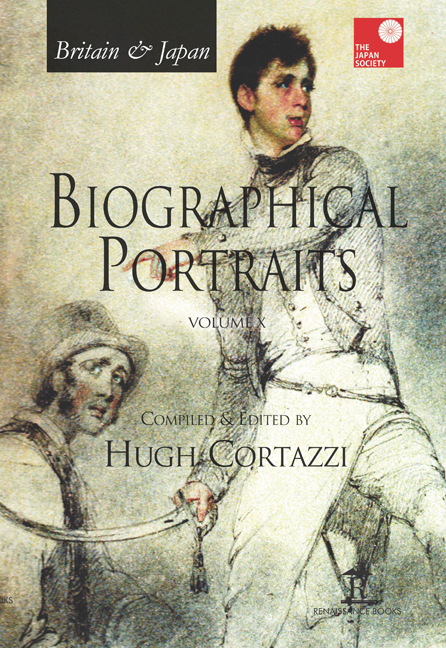Book contents
- Frontmatter
- Dedication
- Contents
- Introduction
- List of Contributors
- Index of Biographical Portraits in Japan Society Volumes
- PART I BRITAIN IN JAPAN
- PART II JAPAN IN BRITAIN
- Select Bibliography of Works in English on Anglo-Japanese Relations [Compiled by Gill Goddard – Retired East Asian Studies Librarian, University of Sheffield]
- Select Bibliography of Works in Japanese on Anglo-Japanese Relations [Compiled by Akira Hirano, SISJAC]
- Index
43 - Wool in Japan: A Very British Story
Published online by Cambridge University Press: 07 May 2022
- Frontmatter
- Dedication
- Contents
- Introduction
- List of Contributors
- Index of Biographical Portraits in Japan Society Volumes
- PART I BRITAIN IN JAPAN
- PART II JAPAN IN BRITAIN
- Select Bibliography of Works in English on Anglo-Japanese Relations [Compiled by Gill Goddard – Retired East Asian Studies Librarian, University of Sheffield]
- Select Bibliography of Works in Japanese on Anglo-Japanese Relations [Compiled by Akira Hirano, SISJAC]
- Index
Summary
INTRODUCTION
IT WAS ONLY when in 2011 I asked the ambassador (Sir David Warren) if I could run a flock of sheep on the lawn of the embassy residence in Tokyo that I realised the only sheep on the island of Honshu were kept in a zoo in Chiba. The idea of an ovine invasion of British diplomatic premises stemmed from witnessing Japanese delight at seeing flocks of Dorset Horn and Bowmont sheep safely grazing on an appropriately grassed-over Savile Row one fine autumn day in early October 2010. This was to celebrate the launch of HRH The Prince of Wales’ Campaign for Wool. Perhaps the most prominent bespoke tailor on the Row participating in the festivities that day was Henry Poole, the company founded in 1806, which famously was the tailor of choice for the Showa Emperor while he was Crown Prince, and again for his son Prince Akihito, now the Heisei Emperor, in 1953 for the coronation of Queen Elizabeth II. A Royal Warrant from Tokyo still sits proudly on the wall in Poole's elegant reception at number 15 Savile Row.
Several houses on the Row can trace strong connections with Japan, particularly in the 1930s. Anda Rowland, owner of Anderson and Sheppard famed for their bespoke business in Hollywood for most of the twentieth century showed me a ledger from 1936 that included several wealthy Japanese customers of the pre-war era. The bespoke tailoring skills of London have been elegantly and faithfully reproduced in Tokyo and can be seen today enjoying the global revival in personal tailoring, often in British fabrics, but also in Italian and Chinese offerings, something that never occurred in the 1930s, but did appear briefly in the 1940s.
English wool cloth had been used in the barter trade with Japan since the early seventeenth century in exchange for locally woven silks. Unlike the sheep, the silk worm and the mulberry bush were common across Japan. The local love of silk for kimonos and other traditional garments no doubt led to a later appreciation of fine wool worsted suitings and bespoke tailoring that continues to thrive today.
PRE-SECOND WORLD WAR
To achieve Japan's military goals in the latter part of the Meiji era the Imperial Army and Navy needed uniform fabrics for the near arctic winters of the northern steppe that send temperatures in Korea to well below zero.
- Type
- Chapter
- Information
- Britain & Japan Biographical Portraits Vol X , pp. 480 - 490Publisher: Amsterdam University PressPrint publication year: 2016

